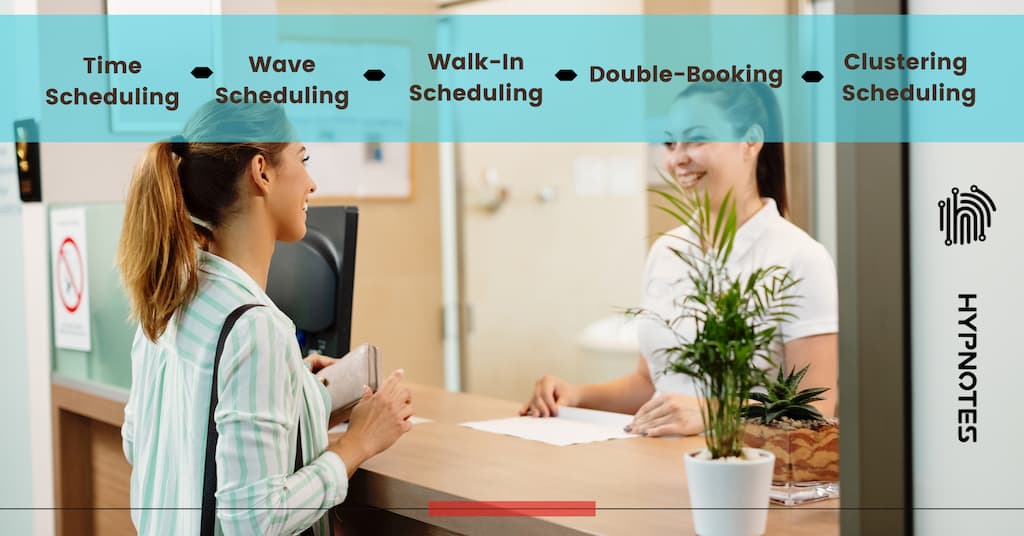A Quick Guide to Patient Scheduling and Appointment Management
Last Updated on September 16, 2023
Efficient patient scheduling and appointment management contribute to the general satisfaction of clients. Healthcare takes more than just providing the solution to a patient’s problem; how easily the patient is able to schedule an appointment in a healthcare facility is also vital.
In this article, we will discuss different scheduling methods for therapists, the principles of appointment management, how to organize patient scheduling, and different tips for improving patient scheduling effectively.
What is Patient Scheduling and Appointment Management?
Patient scheduling and appointment management is arranging a meeting between a patient and a healthcare provider. This process involves selecting a date, time, location, and type of care before going for a medical appointment. Scheduling patient appointments can be done using software or manually.

What is The Purpose of Patient Scheduling and Appointment Management
The purpose of patient scheduling and appointment management is to manage the patient inflow and maximize resources. In addition, appointment scheduling allows the client to select a convenient time based on the therapist’s availability.
Patient scheduling and appointment management helps therapists maximize resources by reducing session cancellations and overbooking. It also helps reduces operational costs for therapists by reducing unregulated patient walk-ins.
Who is Responsible for Scheduling Appointments for Patients?
Generally, different personnel is responsible for scheduling appointments based on the healthcare setting. For example, in a therapist’s office, it might be the job of a receptionist, an assistant, or a therapist scheduler. In addition, some hospitals have a department to manage patient appointments, while some use an electronic or online scheduling system.
The responsibility of managing patient inflow is important in every healthcare facility because it determines the efficiency of that facility. When patient scheduling is properly managed, it leads to better use of resources.
Types of Patient Scheduling and Appointment Management

Patient scheduling and appointment management is an important aspect of healthcare provision and can be done in different ways.
1. Time Scheduling
Time-slot scheduling, as the name suggests, is when patients are allowed to schedule appointments at a particular time. Time-slot scheduling is the most common type of appointment schedule and reduces the waiting time for patients.
It will enable patients to book their appointments at a time that suits them. Also, the therapist can decide the amount of time allotted for each day. The drawback associated with time-slot scheduling is that it can create gaps in the schedule when patients do not turn up.
2. Wave Scheduling
Wave scheduling is another type of scheduling therapists do when they always have patients. Wave scheduling involves seeing patients in batches; for example, the therapist can decide to see five patients every hour.
Wave scheduling is a flexible option for patients because they can come for appointments at any time as long as it is during working hours. Also, wave scheduling allows the therapist to see clients in order of priority. One major disadvantage of wave scheduling is that it can be frustrating for waiting patients.
3. Walk-In Scheduling
Walk-In scheduling is another flexible option for patients where they can set appointments at any time during working hours. Walk-In scheduling is also known as open booking scheduling.
Patients do not require advance notice for walk-In scheduling, which can be overwhelming for the therapist on busy days. In addition, there is no control over the inflow of patients, which can lead to overcrowding of patients in the facility.
4. Double-Booking
Double booking scheduling is an appointment management method that involves booking two patients for one slot. Double booking has its benefits in a situation where the therapist knows one patient is less likely to attend.
Also, the therapist can use this method to see a patient when another patient has a lengthy session. However, like wave scheduling, double booking can be frustrating for waiting patients or when a patient’s slot has been taken.
5. Clustering Scheduling
Clustering scheduling is used where a therapist groups patients with similar complaints for a slot. Clustering scheduling helps the therapist stay in one frame of mind and allows a large number of patients to be seen at the same time. Patient availability might affect clustering scheduling as it may be available at a different time.
What are Patient Scheduling and Appointment Management Principles?
Appointment management principles are guidelines used by healthcare providers to effectively and efficiently facilitate appointment schedules for patients. These principles help healthcare providers save time and maximize resources. The guidelines include the following:
- Accessibility: The appointment scheduling process should be convenient for patients and convenient for them to schedule.
- Flexibility: Patients must be able to book appointments at times that are more convenient, such as evenings and weekends.
- Efficiency: Appointments should be organized and also be able to reduce patients’ wait time. In addition, efficient appointment management will reduce the amount of missed appointments.
- Communication: Regular communication with patients is important for effective appointment management. Communicating about upcoming appointments, missed appointments, and misinformation will be reduced.
- Continuity to Care: Other aspects of healthcare provision, like follow-up appointments and referrals, should be done effectively.
- Data Management: Reviews from patients or feedback are important to improve effective appointment scheduling. In addition, regular monitoring of appointment management will help identify trends that can be improved.
How to Schedule and Organize Patient Appointments?

Every therapist must know how to organize patient appointments to reduce delays and long wait times. This section will discuss different ways to schedule and manage patient scheduling and appointment management.
- Use an Efficient Appointment Scheduling Software: Good appointment scheduling software allows you to schedule appointments, manage patient information, and send patient reminders easily. Hypnotes offers an effective online booking system for therapists, including therapy scheduling software built to make appointment scheduling and management easier.
Hypnotes therapy scheduling software lets you see appointment dates and therapist availability in real time across your Google, Apple, and Outlook calendars. In addition, it is designed with an automated email and SMS system for reminders and follow-up sessions.
Therapists can link the online booking software to their website or social media pages for easy scheduling. Hypnotes online booking will help therapists reduce no-shows and the automation system and make the healthcare provision process convenient for therapists and patients.
- Phone and in-person Scheduling: Appointments can also be scheduled by phone or in person, which is helpful for patients who prefer direct contact.
- Time Slots and Availability: Set specific time slots and ensure that patients have enough availability to schedule appointments to ensure that appointments are scheduled efficiently.
- Cancellation and Rescheduling: To ensure that the appointment management system is efficient, a method for dealing with cancellations and rescheduling must be in place.
- Reminder Calls/Emails: Reminding patients about their appointments is also important to reduce the number of no-shows.
How Do You Schedule Patient Appointments Effectively?
Patient scheduling is necessary for efficient healthcare provision. The following tips help improve appointment management:
- Use a Scheduling Software: The best and easiest way to manage sessions and appointments is by using a scheduling software like Hypnotes online booking system. You can create a clear, organized schedule that will benefit both parties.
- Encouraging Self-Scheduling: You can save time and reduce errors by allowing patients to schedule their own appointments online.
- Effective Communication with Patients: Provide patients with clear information about appointment times, locations, and any required preparation, including important instructions or cancellation policies.
- Flexibility: Patients should be able to book appointments when they are at liberty to do so. Also, patients should be able to reschedule in the case of missed appointments.
- Use Reminders: To avoid no-shows or appointment delays, send reminders to patients via email and SMS. You can send reminders to patients easily when you use Hypnotes’ scheduling software.
Is Appointment Scheduling Important?
Patient scheduling and appointment management is important for the healthcare system because good patient management ensures that healthcare is provided promptly and efficiently. Also, the therapist practice can attend to as many patients as possible.
Some of the reasons why appointment scheduling is important are as follows:
- Better Healthcare Experience for Patients: One of the biggest disappointments of patients is the delay in receiving health care. Effective patient scheduling and appointment management will improve patients’ overall experience by minimizing delays. Ensuring patients can get care when needed without waiting time increases their satisfaction.
- Increased Efficiency: It will increase productivity and save time as the front-desk staff will spend less time and energy on appointments.
- Avoid Miscommunication: Efficient scheduling significantly reduces miscommunication because the scheduling software sends patients the necessary information on time.
- Improves Productivity of the Therapist: By scheduling appointments effectively, therapists will focus more on providing healthcare. In addition, using the right scheduling software will make the therapist more productive because no-shows and missed appointments will be reduced.
- Increased Revenue: Efficient patient scheduling can increase revenue by maximizing the number of patients seen.
- Better Record Keeping: Patient information and appointment history can be tracked with scheduling software, and reports can be generated to analyze appointment management performance.
Conclusion
Patient scheduling and appointment management is one of the key considerations of healthcare. It helps to ensure that patients receive the care they need in a timely and efficient manner without unnecessary delays.
Effective scheduling software makes it easier for therapists to attend to as many patients as possible and set priorities for important cases. In addition, well-managed patient scheduling leads to a better patient healthcare experience, increased efficiency, effective communication, increased revenue, and better record keeping.

